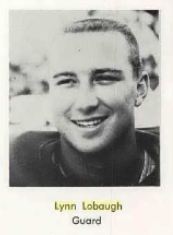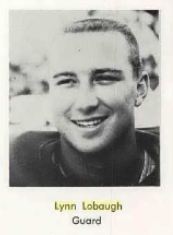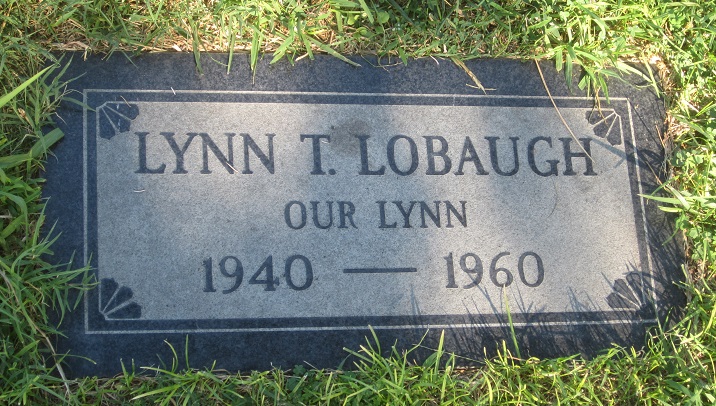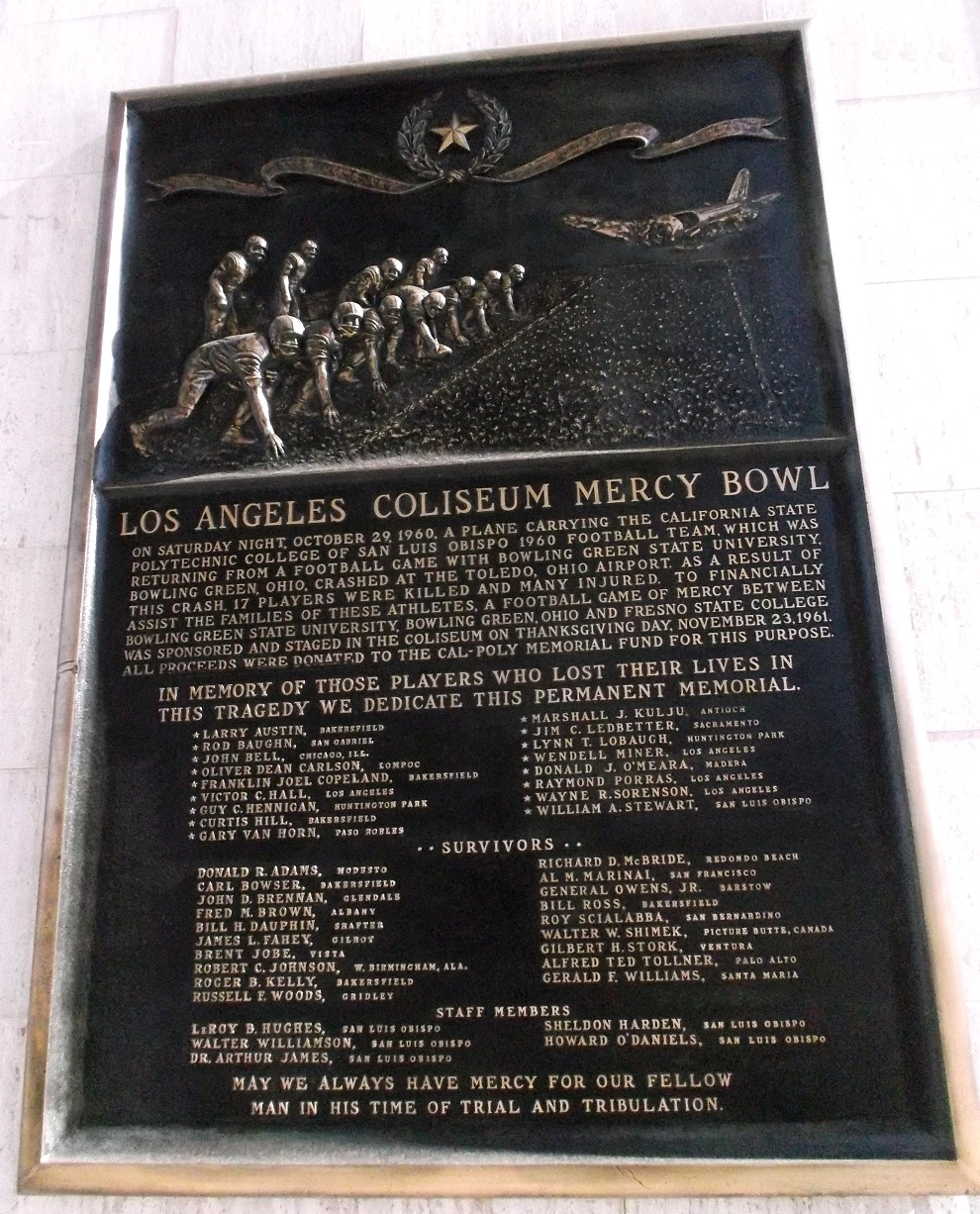Name: Lynn Thomas Lobaugh
Birth Date: 23 Jun 1940
Gender: Male
Mother's Maiden Name: Hummel
Birth County: Los Angeles
Ohio, Deaths, 1908-1932, 1938-2007
Name: Lynn T Lobaugh
Birth Date: 1940
Gender: Male
Race: White
Death Date: 29 Oct 1960
Hospital of Death: Public - Other
Death Place: Lucas, Ohio, USA
Certificate: 81749
Age at Death: 20
Certifier: Coroner
Autopsy: Yes, used for certification
County of Injury: Lucas
Marital Status: Never Married (Single)
Census Tract: 0000
45th anniversary for plane crash survivors
October 28, 2005
Tomorrow marks the 45th anniversary of the plane crash that killed 22 people, including 16 Cal Poly football players.
The Arctic-Pacific C-46 plane went down after its left engine failed shortly after takeoff from the Toledo airport in Ohio. At the time it was the worst sports air disaster in U.S. history. Only 26 people survived. One of those survivors is the new offensive coordinator of the Detroit Lions, Ted Tollner.
“You try to do the best to appreciate the life that you have been given,” Tollner said.
Tollner was the starting quarterback for Cal Poly for two years, and since then has coached for the Bills, 49ers, Rams and Chargers. Tollner was also the coach for USC from 1982-86. Remembering the night he was pulled from the burning plane; Tollner said there are two sides.
“There’s the good fortune of living and the grief of thinking of the people who didn’t make it,” Tollner said.
Johnny Nettleship, another survivor, was covering the game for the Telegram-Tribune, now the Tribune. He was sports editor on the paper from 1950 until 1980, and passed away January 25, 2005, at the age of 88.
Carl Bowser, another survivor was inducted into the Cal Poly hall of fame in 2002.
Some survivors of the crash meet every June at ex-teammate Rich Max’s home according to the Tribune.
After the crash, a game of mercy was played between Bowling Green State University and Fresno state on Thanksgiving. All proceeds of the game were donated to the Cal Poly memorial fund. The new Cal Poly football stadium will contain a memorial to the players who died.
“An important part of the renovation of our stadium is our goal to recognize and honor all of the members of the 1960 football team who perished in a tragic plane crash in Ohio,” said Cal Poly President Warren Baker.
The plan calls for a memorial plaza next to the stadium, which will contain a copper pillar for each player that died. Each pillar will be the height of that player and contain a biographical plaque.
The players who lost their lives: Larry Austin, Rob Baugen, John Dell, Oliver Dean Carlson, Franklin Joel Copeland, Victor C. Hall, Guy C. Hennigan, Curtis Hill, Gary Van Horn, Marshall J. Kuljo, Jim C. Ledbeter, Lynn T. Lobaugh, Wendell Miner, Donald J. O’Meara, Raymond Porras, Wayne R. Sorensen and William A. Stewart.
Horror of 22 killed in plane crash at Toledo Express
Fifty years ago Friday, a chartered airliner sped down the runway at Toledo Express Airport on one of the foggiest nights ever in northwest Ohio.
Onboard was the California State Polytechnic College football squad, glum after a 50-6 loss that afternoon to Bowling Green State University.
The propeller plane, later determined to be overloaded and underpowered, fish-tailed as it gathered speed yet managed to get about 100 feet off the ground. Then the left engine died.
The craft flipped tail-over-nose, crashing at the edge of the main east-west runway at 11:02 p.m. It broke in two and burst into flames. Those in the front seats were killed as fire engulfed the cabin.
Twenty-two people died in the crash of Oct. 29, 1960, including 16 football players, a student manager, a team booster, the pilot, the co-pilot, and the co-pilot's mother and sister-in-law.
Of the 48 persons aboard the Arctic-Pacific chartered plane, another 22 were seriously injured. Some remained hospitalized for months in Toledo with injuries that torment them to this day.
It was the worst sports team air disaster in U.S. history at that time.
image: http://www.toledoblade.com/image/2010/10/29/300x_b1_a4-3_cCM_z/Horror-of-22-killed-in-plane-crash-at-Toledo-Express-remains-but-area-lacks-memorial-2.jpg
The 1960 plane crash in heavy fog killed 22, including 16 players, a student manager, a team booster, pilot, co-pilot, and the co-pilot's mother and sister-in-law. The 1960 plane crash in heavy fog killed 22, including 16 players, a student manager, a team booster, pilot, co-pilot, and the co-pilot's mother and sister-in-law.
BLADE Enlarge
"That was such a huge event in the history of our school and in our lives," said Bill Dauphin, 69, of Scotts Valley, Calif., a left tackle for the Cal Poly Mustangs who was thrown onto the runway as the plane hit the ground.
Now a half-century later, the air tragedy's survivors are preparing to mark the anniversary this weekend at Cal Poly's home football game. Here in Ohio, the widow of a first responder is leading an effort to create the first local memorial for the crash.
"I just can't believe that 50 years later, we have done nothing to remember what happened here," said Martha Hogle, 75, now of Perrysburg. Her late husband, Robert Hogle, was a Toledo police officer who, like other responders, struggled against blinding fog to reach the scene.
The visibility that evening was so poor that emergency personnel couldn't find the burning wreckage until they got within 100 feet of it. Yet sky caps, mechanics, ticket clerks, and other terminal workers dashed to the scene as fast they could on tractors and baggage carts.
Joining them were members of the National Guard, many in Halloween costumes from a party in a nearby hangar. Crews described the scene as "a mountain of debris."
As news of the accident hit the airwaves, traffic flooded Airport Highway as residents set out to glimpse the disaster. Mrs. Hogle was two days away from giving birth and remembers the shock of the crash and her anxiety upon hearing her husband receive orders to immediately report to the airport.
"I remember that fog - it was like pea soup - and I did not want my husband to go out that night," she said. "There was just one steady stream of traffic out there, not just police but regular people going out to see."
image: http://www.toledoblade.com/image/2010/10/29/300x_b1_a4-3_cCM_z/Horror-of-22-killed-in-plane-crash-at-Toledo-Express-remains-but-area-lacks-memorial-3.jpg
Former Cal Poly football player Gil Stork survived the crash which killed 16 of his teammates. He sits next to a memorial stone on campus honoring the victims. Former Cal Poly football player Gil Stork survived the crash which killed 16 of his teammates. He sits next to a memorial stone on campus honoring the victims.
JJ Enlarge
Arctic-Pacific was soon out of business. The Federal Aviation Agency in July had ordered revocation of the pilot's licence for violating regulations, but the matter was under appeal. A notice from the airline that it was firing the pilot, Donald L. Chesher, was received by the Civil Aeronautics Board two days after the crash.
Two years later in its investigative report, the CAB faulted the airline and the pilot for "utter disregard" of numerous regulations and factors. Despite control tower warnings, Mr. Chesher had insisted on departing regardless of the conditions.
The Curtiss C-46F plane was found to be 2,000 pounds over its certified weight. The faulty left engine, acquired from Air Force surplus, was improperly installed and not certified for the aircraft. Also noted was that the pilot and co-pilot had been on flight duty for more than 26 hours.
Visibility was just about zero. On receiving take-off clearance, the pilot remarked that he only could see three runway lights and asked how far apart they were. The control tower told him 300 feet, but the distance really was 200 feet, the report said.
The Federal Aviation Authority revised its regulations after the crash, ordering that air traffic controllers, rather than pilots, authorize departures.
Ted Tollner is still haunted by flashbacks. Cal Poly's quarterback is now an NFL passing game coordinator for the Oakland Raiders. Five decades have passed since the crash, yet he vividly remembers the sense of anxiety in the plane's cabin prior to takeoff.
He was seated by the aircraft's left wing near the engine, "and I can still hear it going out and sputtering and stopping." Then there was the crash, the deafening explosions, the blinding fire. The scene replays in his mind each time he's on a plane in foggy weather.
"I've never missed any flights because of it, but my body reacts to it," said Mr. Tollner, 70, who's enjoyed a decades-long coaching career after severe leg injuries from the crash precluded him from playing in the NFL.
Though it's an everyday pain for him to walk, he doesn't complain as he knows teammates on the plane who live with much worse constant pain.
Both he and Mr. Dauphin said they remain thankful for the support they received from the Toledo and BGSU communities in the wake of the crash.
"I will never forget the generosity and understanding of the Red Cross and the people of the Toledo area who tried to make us comfortable under very very difficult circumstances," Mr. Tollner said. "That's something you never forget either."
Ed Phillips, a guard and linebacker for the Falcons in the Cal Poly game, recalled how his team and the entire BGSU campus were in shock for weeks.
The Falcons were booked to fly Arctic-Pacific Airlines two weeks later for an away game against the University of Texas at El Paso. Because the airline was grounded, the team took a vote on whether to rebook with another airline or opt for a two-day train trip to Texas, recalled Mr. Phillips, who is 71 and lives outside of Dayton.
They took the train.
Mr. Dauphin spent two weeks in Toledo Hospital after surviving the crash. Along with his mother and another injured teammate, he returned to Toledo Express on crutches to catch a flight home to California.
"We were just scared to death," he said. "I can't remember a time being more afraid to do something, but we wanted to get home so bad."
In 2002, Cal Poly football returned to Toledo for the first time since the air tragedy. The team played the University of Toledo, which won 44-16 in a season opener at the Glass Bowl. For this trip, Cal Poly flew into Detroit Metro Airport.
Cal Poly football players have for years touched a memorial stone in their home stadium honoring the 1960 team before every game and road trip.
In 2006, the college dedicated a larger crash memorial of 18 copper pillars aligned in a circular formation resembling a football huddle. Each column is identical in height to the deceased player or supporter it represents, and includes an etching of the person.
Mrs. Hogle recently began working with the Toledo-Lucas County Port Authority to have a first-ever local memorial for the crash in place by next spring. She envisions a small garden and a marker on airport grounds to tell people what happened the night of Oct. 29, 1960.
"It's a part of Toledo's history," she said.
Name: Lynn Thomas Lobaugh
Birth Date: 23 Jun 1940
Gender: Male
Mother's Maiden Name: Hummel
Birth County: Los Angeles
Ohio, Deaths, 1908-1932, 1938-2007
Name: Lynn T Lobaugh
Birth Date: 1940
Gender: Male
Race: White
Death Date: 29 Oct 1960
Hospital of Death: Public - Other
Death Place: Lucas, Ohio, USA
Certificate: 81749
Age at Death: 20
Certifier: Coroner
Autopsy: Yes, used for certification
County of Injury: Lucas
Marital Status: Never Married (Single)
Census Tract: 0000
45th anniversary for plane crash survivors
October 28, 2005
Tomorrow marks the 45th anniversary of the plane crash that killed 22 people, including 16 Cal Poly football players.
The Arctic-Pacific C-46 plane went down after its left engine failed shortly after takeoff from the Toledo airport in Ohio. At the time it was the worst sports air disaster in U.S. history. Only 26 people survived. One of those survivors is the new offensive coordinator of the Detroit Lions, Ted Tollner.
“You try to do the best to appreciate the life that you have been given,” Tollner said.
Tollner was the starting quarterback for Cal Poly for two years, and since then has coached for the Bills, 49ers, Rams and Chargers. Tollner was also the coach for USC from 1982-86. Remembering the night he was pulled from the burning plane; Tollner said there are two sides.
“There’s the good fortune of living and the grief of thinking of the people who didn’t make it,” Tollner said.
Johnny Nettleship, another survivor, was covering the game for the Telegram-Tribune, now the Tribune. He was sports editor on the paper from 1950 until 1980, and passed away January 25, 2005, at the age of 88.
Carl Bowser, another survivor was inducted into the Cal Poly hall of fame in 2002.
Some survivors of the crash meet every June at ex-teammate Rich Max’s home according to the Tribune.
After the crash, a game of mercy was played between Bowling Green State University and Fresno state on Thanksgiving. All proceeds of the game were donated to the Cal Poly memorial fund. The new Cal Poly football stadium will contain a memorial to the players who died.
“An important part of the renovation of our stadium is our goal to recognize and honor all of the members of the 1960 football team who perished in a tragic plane crash in Ohio,” said Cal Poly President Warren Baker.
The plan calls for a memorial plaza next to the stadium, which will contain a copper pillar for each player that died. Each pillar will be the height of that player and contain a biographical plaque.
The players who lost their lives: Larry Austin, Rob Baugen, John Dell, Oliver Dean Carlson, Franklin Joel Copeland, Victor C. Hall, Guy C. Hennigan, Curtis Hill, Gary Van Horn, Marshall J. Kuljo, Jim C. Ledbeter, Lynn T. Lobaugh, Wendell Miner, Donald J. O’Meara, Raymond Porras, Wayne R. Sorensen and William A. Stewart.
Horror of 22 killed in plane crash at Toledo Express
Fifty years ago Friday, a chartered airliner sped down the runway at Toledo Express Airport on one of the foggiest nights ever in northwest Ohio.
Onboard was the California State Polytechnic College football squad, glum after a 50-6 loss that afternoon to Bowling Green State University.
The propeller plane, later determined to be overloaded and underpowered, fish-tailed as it gathered speed yet managed to get about 100 feet off the ground. Then the left engine died.
The craft flipped tail-over-nose, crashing at the edge of the main east-west runway at 11:02 p.m. It broke in two and burst into flames. Those in the front seats were killed as fire engulfed the cabin.
Twenty-two people died in the crash of Oct. 29, 1960, including 16 football players, a student manager, a team booster, the pilot, the co-pilot, and the co-pilot's mother and sister-in-law.
Of the 48 persons aboard the Arctic-Pacific chartered plane, another 22 were seriously injured. Some remained hospitalized for months in Toledo with injuries that torment them to this day.
It was the worst sports team air disaster in U.S. history at that time.
image: http://www.toledoblade.com/image/2010/10/29/300x_b1_a4-3_cCM_z/Horror-of-22-killed-in-plane-crash-at-Toledo-Express-remains-but-area-lacks-memorial-2.jpg
The 1960 plane crash in heavy fog killed 22, including 16 players, a student manager, a team booster, pilot, co-pilot, and the co-pilot's mother and sister-in-law. The 1960 plane crash in heavy fog killed 22, including 16 players, a student manager, a team booster, pilot, co-pilot, and the co-pilot's mother and sister-in-law.
BLADE Enlarge
"That was such a huge event in the history of our school and in our lives," said Bill Dauphin, 69, of Scotts Valley, Calif., a left tackle for the Cal Poly Mustangs who was thrown onto the runway as the plane hit the ground.
Now a half-century later, the air tragedy's survivors are preparing to mark the anniversary this weekend at Cal Poly's home football game. Here in Ohio, the widow of a first responder is leading an effort to create the first local memorial for the crash.
"I just can't believe that 50 years later, we have done nothing to remember what happened here," said Martha Hogle, 75, now of Perrysburg. Her late husband, Robert Hogle, was a Toledo police officer who, like other responders, struggled against blinding fog to reach the scene.
The visibility that evening was so poor that emergency personnel couldn't find the burning wreckage until they got within 100 feet of it. Yet sky caps, mechanics, ticket clerks, and other terminal workers dashed to the scene as fast they could on tractors and baggage carts.
Joining them were members of the National Guard, many in Halloween costumes from a party in a nearby hangar. Crews described the scene as "a mountain of debris."
As news of the accident hit the airwaves, traffic flooded Airport Highway as residents set out to glimpse the disaster. Mrs. Hogle was two days away from giving birth and remembers the shock of the crash and her anxiety upon hearing her husband receive orders to immediately report to the airport.
"I remember that fog - it was like pea soup - and I did not want my husband to go out that night," she said. "There was just one steady stream of traffic out there, not just police but regular people going out to see."
image: http://www.toledoblade.com/image/2010/10/29/300x_b1_a4-3_cCM_z/Horror-of-22-killed-in-plane-crash-at-Toledo-Express-remains-but-area-lacks-memorial-3.jpg
Former Cal Poly football player Gil Stork survived the crash which killed 16 of his teammates. He sits next to a memorial stone on campus honoring the victims. Former Cal Poly football player Gil Stork survived the crash which killed 16 of his teammates. He sits next to a memorial stone on campus honoring the victims.
JJ Enlarge
Arctic-Pacific was soon out of business. The Federal Aviation Agency in July had ordered revocation of the pilot's licence for violating regulations, but the matter was under appeal. A notice from the airline that it was firing the pilot, Donald L. Chesher, was received by the Civil Aeronautics Board two days after the crash.
Two years later in its investigative report, the CAB faulted the airline and the pilot for "utter disregard" of numerous regulations and factors. Despite control tower warnings, Mr. Chesher had insisted on departing regardless of the conditions.
The Curtiss C-46F plane was found to be 2,000 pounds over its certified weight. The faulty left engine, acquired from Air Force surplus, was improperly installed and not certified for the aircraft. Also noted was that the pilot and co-pilot had been on flight duty for more than 26 hours.
Visibility was just about zero. On receiving take-off clearance, the pilot remarked that he only could see three runway lights and asked how far apart they were. The control tower told him 300 feet, but the distance really was 200 feet, the report said.
The Federal Aviation Authority revised its regulations after the crash, ordering that air traffic controllers, rather than pilots, authorize departures.
Ted Tollner is still haunted by flashbacks. Cal Poly's quarterback is now an NFL passing game coordinator for the Oakland Raiders. Five decades have passed since the crash, yet he vividly remembers the sense of anxiety in the plane's cabin prior to takeoff.
He was seated by the aircraft's left wing near the engine, "and I can still hear it going out and sputtering and stopping." Then there was the crash, the deafening explosions, the blinding fire. The scene replays in his mind each time he's on a plane in foggy weather.
"I've never missed any flights because of it, but my body reacts to it," said Mr. Tollner, 70, who's enjoyed a decades-long coaching career after severe leg injuries from the crash precluded him from playing in the NFL.
Though it's an everyday pain for him to walk, he doesn't complain as he knows teammates on the plane who live with much worse constant pain.
Both he and Mr. Dauphin said they remain thankful for the support they received from the Toledo and BGSU communities in the wake of the crash.
"I will never forget the generosity and understanding of the Red Cross and the people of the Toledo area who tried to make us comfortable under very very difficult circumstances," Mr. Tollner said. "That's something you never forget either."
Ed Phillips, a guard and linebacker for the Falcons in the Cal Poly game, recalled how his team and the entire BGSU campus were in shock for weeks.
The Falcons were booked to fly Arctic-Pacific Airlines two weeks later for an away game against the University of Texas at El Paso. Because the airline was grounded, the team took a vote on whether to rebook with another airline or opt for a two-day train trip to Texas, recalled Mr. Phillips, who is 71 and lives outside of Dayton.
They took the train.
Mr. Dauphin spent two weeks in Toledo Hospital after surviving the crash. Along with his mother and another injured teammate, he returned to Toledo Express on crutches to catch a flight home to California.
"We were just scared to death," he said. "I can't remember a time being more afraid to do something, but we wanted to get home so bad."
In 2002, Cal Poly football returned to Toledo for the first time since the air tragedy. The team played the University of Toledo, which won 44-16 in a season opener at the Glass Bowl. For this trip, Cal Poly flew into Detroit Metro Airport.
Cal Poly football players have for years touched a memorial stone in their home stadium honoring the 1960 team before every game and road trip.
In 2006, the college dedicated a larger crash memorial of 18 copper pillars aligned in a circular formation resembling a football huddle. Each column is identical in height to the deceased player or supporter it represents, and includes an etching of the person.
Mrs. Hogle recently began working with the Toledo-Lucas County Port Authority to have a first-ever local memorial for the crash in place by next spring. She envisions a small garden and a marker on airport grounds to tell people what happened the night of Oct. 29, 1960.
"It's a part of Toledo's history," she said.
Sponsored by Ancestry
Advertisement
Advertisement




